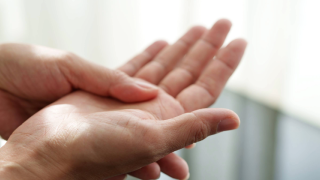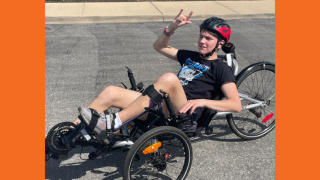Body
What is Rehabilitation?
Physical medicine and rehabilitation (PM&R), also known as physiatry or rehabilitation medicine, aims to enhance and restore functional ability and quality of life to those with physical impairments or disabilities affecting the brain, spinal cord, nerves, bones, joints, ligaments, muscles, and tendons. Starting rehabilitation is actually a milestone in recovery because it requires that a patient be both medically stable and strong enough to participate in therapy.
The process of rehabilitation involves a team of professionals who work with a patient and family, using education, various therapies and practical experiences, to achieve the highest level of independence possible. Rehabilitation can occur in the inpatient, outpatient, or Day Rehabilitation setting. The team with the patient and family establish individual goals for each patient depending upon life circumstances, personality, and interests. Therapeutic goals, in general, for rehabilitation are to:
• Increase strength, endurance, and mobility,
• Improve ability to perform activities of daily living,
• Improve communication and thinking skills.
Many patients who do return home after an inpatient hospital stay continue with therapy. There are two options. Day rehabilitation is an individually designed full or half day program for those who require more than one type of therapy (OT, PT, SLP). These are scheduled together in one site and transportation may be available. Individual outpatient therapies can also be obtained at outpatient centers in the community. In-home therapy is an option for those who cannot easily travel outside of the house.
Tips for Patients
Rehabilitation is a very active process and patient involvement is important. Active participation in the therapy sessions and ongoing communication with the health care team members are important for a successful rehabilitation experience.
• Talk to your care manager about anything that could affect the rehabilitation process.
• Learn the names of the therapy team and communicate with them regularly.
• Arrive for therapies on time and give the best possible effort.
• Engage with the team in planning for discharge. Patients can identify a main caregiver who is responsible for learning home care. Note that any family member or friend with whom you are comfortable can learn and participate in your care.
Rehabilitation Team
The rehabilitation team uses an interdisciplinary team approach is used to design a program for with patient. Your team meets daily to discuss medical status and progress. You and your family are an important part of this team effort. We want you to identify specific goals so to incorporate into your treatment program. The following types of health care providers may be part of your team in addition to others.
Physician
Rehabilitation physicians are specialists in Physical Medicine and Rehabilitation and are called physiatrists. The goals of the physiatrist are to maximize patients’ independence in activities of daily living and improve quality of life. This doctor does not replace your family doctor.
Nurse Practitioner (NP) and Physician Assistant (PA)
An NP or PA assists the physician with daily care and rounding on the physician’s respective patients. They are involved in managing the patient care and communicating with the team.
Nurse
Nurses (RN) coordinate daily care and constantly assess patients’ needs. They give medications, provide wound care, bowel and bladder management, skin care, and assist the team with pain management. The RN does discharge planning and teaching, actively involving you and family members.
Patient Care Technicians (PCT)
Patient care technicians are assigned to each inpatient around the clock to help with bathing, showering, dressing, eating, transfers, turning, positioning and toileting.
Occupational Therapist (OT)
Occupational therapy works on activities of daily living (ADL) such as:
• Dressing, bathing, toileting,
• Leisure time and hobbies,
• Work related tasks,
• Visual, thinking and planning skills,
• Use of adaptive equipment if necessary.
Physical Therapist (PT)
Physical therapy works on mobility including:
• Using a wheelchair,
• Transferring, such as from a wheelchair to the car,
• Walking, with or without equipment,
• Exercises for strengthening muscles and joints,
• Identify needs for home modification and equipment.
Both physical and occupational therapy work to:
• Improve range of motion in joints, reducing stiffness,
• Reduce pain,
• Improve balance and coordination,
• Prepare patients for self-care at home including cooking, housekeeping, shopping, and practicing "real world" situations which involve attention, cognitive skills, safety awareness, and problem solving.
Speech Language Therapist (SLP)
Speech language therapy addresses:
• Communication – both speaking and understanding,
• Cognition – memory and awareness,
• Swallowing, eating and drinking.
Care Manager
The care manager conveys information from team conferences on weekly progress, and provides assistance with social and community needs such as:
• Local resources,
• Medical supplies,
• Referrals for continued therapy, and follow up medical appointments.
Therapeutic Recreational Specialist
The therapeutic recreation specialist helps patients and families in applying skills learned in rehabilitation to activities that support their personal growth and active community participation. Some activities may include:
• developing self-confidence and comfort in social situations both at home and in the community,
• experiencing individual and group activities to practice skills and develop strategies to nurture friendships and social support networks,
• finding new ways to pursue old interests through adaptations
• identifying new areas of interest.
Clinical Dietitian
The clinical dietitian evaluates nutritional needs based on physicians' orders and medical condition. This can include:
• help with special diets as prescribed,
• general information on maintaining a healthy diet.
Psychologist
The rehabilitation psychologist meets with patients, family, and significant others to help with adjustment to hospitalization and disability. The psychologist collaborates with the rehabilitation team to support psychological and interpersonal functioning.
Neuropsychologist
The neuropsychologist tests for thinking abilities and provides help with:
• understanding the links between brain injury, brain functioning and behavior,
• attention, memory, problem–solving skills, language skills and other areas of thinking,
• vocational recommendations,
• adjusting and coping with changes from a brain injury.
Vocational Rehabilitation Specialist
The vocational specialist assists with concerns and needs for returning to school or work:
• meeting with and educating employer or school staff regarding needs for reasonable accommodations,
• identifying educational or employment opportunities of interest,
• developing strategies for work or school reentry.
Prosthetist or Orthotist
Provides care for anyone requiring an artificial limb (prosthesis) or devices to support part of the body (orthosis) such as braces, splints or special footwear.
Chaplain and Spiritual Care
When a life–changing event occurs, spiritual needs may become heightened and yet they may be difficult to express. The chaplain can help with spiritual support during a hospital stay. This support may include the following:
• Facilitating Religious Services such as, Catholic Mass, Interfaith Christian Sunday Services, Seder celebrations and Jewish Holiday celebrations, Ramadan observance and space for daily Muslim prayer all year round,
• Responding to other opportunities as requested in our chapel such as weddings, Bar Mitzvahs, memorial services,
• Meeting individually with patients and patient families,
• Leading mindfulness experiences.
Research
Researchers may invite patients and families to learn about or participate in research projects related to their health condition.
Respiratory Therapist (RT)
The RT helps with any breathing difficulties with may limit participation in other treatment activities.
• measure needs for supplemental oxygen and fit proper equipment,
• use treatments to help with coughing and keeping lungs clear,
• administer medications to open airways,
• work with necessary equipment.
References:
1American Association of Physical Rehabilitation & Medicine.
Body
This content is for informational purposes only and may not be comprehensive. Information contained does not imply an endorsement from Shirley Ryan AbilityLab, and does not replace the advice of a qualified healthcare professional. See here for further details. © Shirley Ryan AbilityLab (formerly Rehabilitation Institute of Chicago). Henry B. Betts LIFE Center – (312) 238-5433 – https://www.sralab.org/lifecenter.



